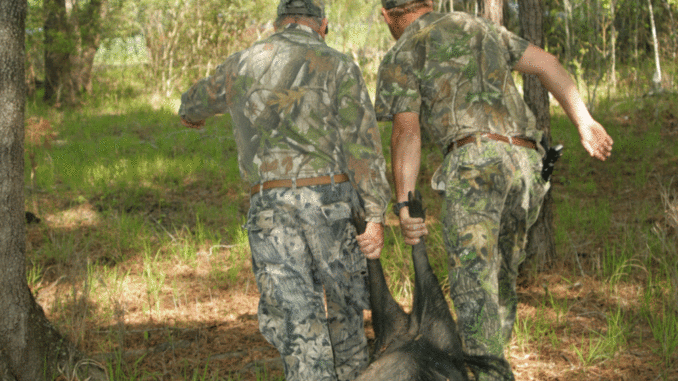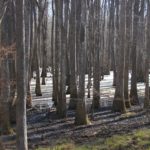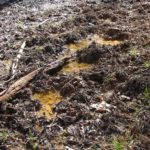
Hog hunting is a great way to extend the big-game season into January. Here’s how to get a leg up on a great barbecue.
Hunting season for many Lowcountry sportsmen doesn’t end when the proverbial end-of-deer-season-bell rings an hour after sunset on New Year’s Day. While many have certainly taken advantage of the opportunity to hunt wild hogs throughout deer season, it has, for some, been a side sport. Now, it’s time to focus on hunting pigs.
For some hunters, the season on hogs never ends and they hunt with a passion year-round. And it’s a good thing hunter are focusing on wild pigs, because the population of feral hogs seems to be expanding throughout South Carolina, with the Lowcountry population literally booming.
Gene Morris, a wildlife officer for the S.C. Department of Natural Resources, has worked the feral hog issue for a number of years and describes the growth of the hog population in terms anyone can understand.
“Basically, there are two types of hunting lands in South Carolina right now,” he said. “There are lands that already have hogs — often way too many hogs — and there is the land that will soon have way too many hogs.”
So the extension of hunting season from deer to hogs is something that just seems right to do — at least it’s that way for several Lowcountry hunters.
Freeman Lincoln, 66, is a retired iron worked from Shulerville in Berkeley County who has property located right in the heart of, and surrounded by, the Francis Marion National Forest. His family also owns several hundred acres in Charleston County, another of his favored hog-hunting spots. Lincoln loves to hunt deer, but hog hunting has been his passion since he was a young lad following his dad around decades ago in those great woods that are now the Francis Marion National Forest.
“I cannot remember a time I haven’t hunted hogs,” Lincoln said. “During a lifetime of hunting and trapping them, I’ve found there are several things essential to successfully hunting hogs, at least in the Lowcountry areas.”
Lincoln said that while hog hunting is good year-round, the winter months are very productive, and hogs are fairly predictable in terms of where they can be found.
“Hogs are like most game species in that they are going to be found where there is ample food and low (hunting) pressure,” he said. “During January and through the winter, that usually means swamps. First, there’s acorns for them to feed on, as well as other food. Plus, after a season of deer hunting, they have been shot at, run by dogs and otherwise pursued to the point they will naturally gravitate to the thick cover of swamps and the wet riverbottoms. That’s where I find most of my hogs during the first few months of the year.
“During the warmer months, again because of food availability such as low bush huckleberries and other forage, they’ll move out of those swamps to higher ground, especially prior to deer season when the hunting pressure and human intrusion is low. For those who hunt year-round, they need to watch for this change and move with the hogs. As the food sources and the human pressure change, so will the habitat they will be found.
“Also, while they’ll gladly eat any acorn, if you can find a big white oak loaded with acorns, I can guarantee it’s a natural attractant for hogs,” Lincoln said. “I do most of my hunting with a .243 rifle and like to shoot them in the neck. A well-placed shot with that weapon will drop him right in his tracks.”
Lincoln said the process to getting where he can get that neck shot is the key to success.
“Even though you may have their general location as being in the swamps and associated thickets, most of our lowcountry swamps are rather large,” he said. “Plus there’s usually plenty of areas where they can find plenty to eat. That’s why it’s essential to get out and scout and find fresh sign. That’s one of the good things about hunting hogs in the swamps; they leave plenty of fresh rooting sign where they’ve been recently. Odds are very high that if you find a place they’ve been feeding heavily, get back in there and set up, and you’re likely to have hogs all around you.”
Lincoln said that hunting while scouting is another great way to take these tusked beasts.
“Hogs employ the use of scent to the max,” he said, “but a hunter that still-hunts on foot and has the wind to his advantage, can often walk right up on pigs in the Lowcountry swamps. That’s where the heavy cover can be a keen advantage to the hunter, and I’ll use that against the hogs. That is a favorite way for me to hunt. It’s not always easy, but there are some things that will enhance your odds of success.
“First, keep the wind in your favor,” he said. “Hogs have a natural character flaw a hunter can use against them, and that is that they are noisy. They grunt a lot, squeal when they frequently fight, and just otherwise make a good bit of noise as they meander though the swamp or woods, rooting and scouring for food. Often, I can hear hogs well off in the distance. Then, I can get a good idea of the direction they are moving, calculate the wind and figure a path to intercept them. I can also stay unseen using the natural cover or slight dips in the terrain. That is great sport, to be able to slip up on a hog, or better yet, a whole bunch of hogs. It’s not unusual to have several hogs in close range, and a good shot can get a couple or more hogs easily.”
Another Lowcountry hunter is Bob Matthews, 64, a preacher from Ladson who loves the great outdoors. Matthews hunts throughout the Lowcountry but has some special spots reserved along the Santee River.
“A river draining is a natural travel corridor for pigs,” Matthews said. “Often it’s swampy, but not always wet throughout the area. During the winter, they’ll stay in those areas for the most part. The key for me is to find where they are today. They do move around a good bit when foraging naturally.”
Matthews said by using corn, hunters can bait up a spot and get the hogs coming to it regularly, but that’s usually a short-term proposition.
“Hogs are smart and they catch on real quick when coming to bait and getting shot at,” Matthews said. “Baiting works, and you can kill hogs over corn, for sure. But kill a couple nice hogs in a specific place, and you can bet they’ll figure out something’s wrong and move on. That’s where knowing their general habitats and movements are the key to consistent success. A lot of hogs are killed by deer hunters during deer season, and the same baiting will work afterwards. But targeting hogs in the swamps and riverbottoms is the essence of the sport.
“I have a nephew, Will McElveen, who loves to hunt them with a bow, but I prefer a .270 rifle,” Matthews said.
McElveen said that hunting hogs with a bow is not only great fun in the Lowcountry swamps, but he learns a lot about late-season deer and preseason turkeys at the same time.
“It’s great fun on its own, but during January I do it to also learn about late-season deer habits, and it helps me begin to get an idea where the turkey are as well. I look for the fresh sign and will either use a climber or a ground blind. I’ve found that a ground blind is something pigs will get used to quickly; just place it in a high use area and leave it alone for a couple days before coming back to hunt. But I do make sure the wind is right before hunting from the ground or climbing stand.”
Matthews said that one of the ways to hunt hogs is with dogs, which he did a lot in the past but not so much now.
“It is very effective, and the use of dogs for hog hunting is a great way to get hogs, but not a lot of people have dogs purely for hog hunting,” he said. “But for those who do, it’s great sport and tons of fun.”
Matthews said that while some hunters will catch the hogs, tie them up and haul them out to feed them before butchering them, he always just shot them, even when hunting with dogs.
“It’s tricky enough using a gun, and my favorite dog-hunting hog story is a time when the dogs had a hog bayed in a thick, briar-infested depression,” Matthews said. “I literally had to crawl in to the place where the dogs had the hog bayed. When I got there, the dogs backed off, I shot the hog and instead of rolling over dead as I expected, it reared up on its back feet and started coming towards me, like what we’ve seen in pictures of attacking grizzly bears. I had never experienced that before, but I had a shotgun with 00 buckshot, and I poured the other four rounds into him at point blank range. The 234-pound boar fell dead where I had been standing. I had backed up into the gnarly thicket by that point.
“Don’t let anyone tell you hog hunting with dogs isn’t exciting,” he said.
Matthews, like Lincoln, said stalking is a favorite technique, and one good thing about the swamps is to take advantage of the wet areas for a silent approach.
“You’ve got to use the wind to your favor, but I also figure a game plan where I can use the natural water in a swamp to hide my sound,” Matthews said. “If everything is wet, it doesn’t matter, but here are times during cold, dry spells in the winter when areas of the swamp have ‘crunchy’ noisy leaves. I use that to help listen for hogs, but it’s something as a hunter, I avoid.”
Hog hunting is open year-round, but January right through the cold months is a prime time to hunt Lowcountry hogs in a wide variety of ways. It’s time to don your warm clothes and get in the swamps and riverbottoms with the hogs and extend your hunting season.
Plus, as McElveen said, you can learn a little more about your other favored species as well.








Be the first to comment